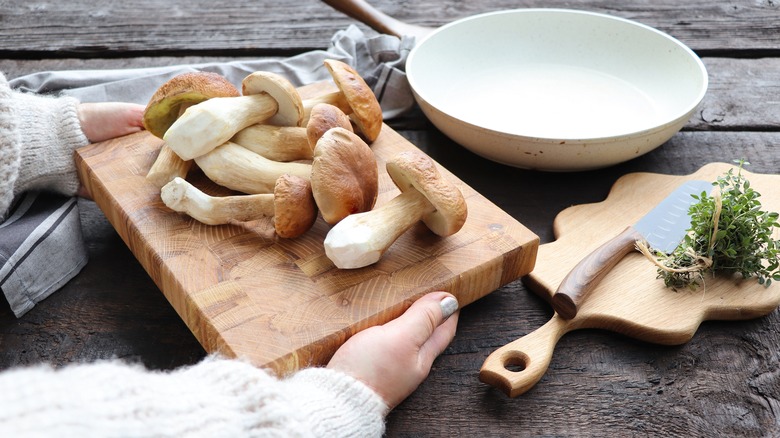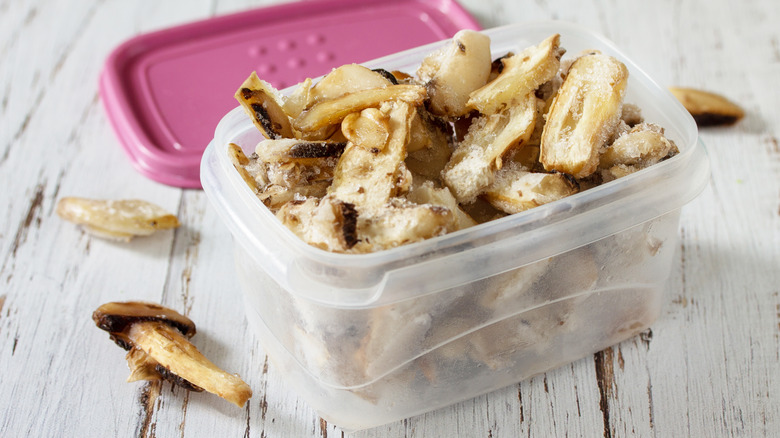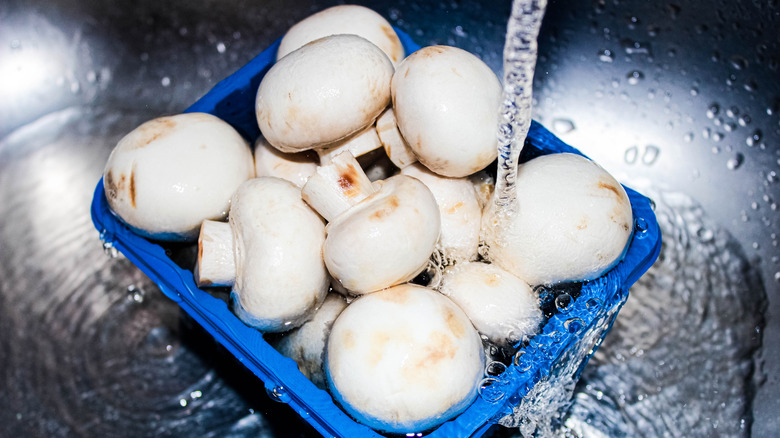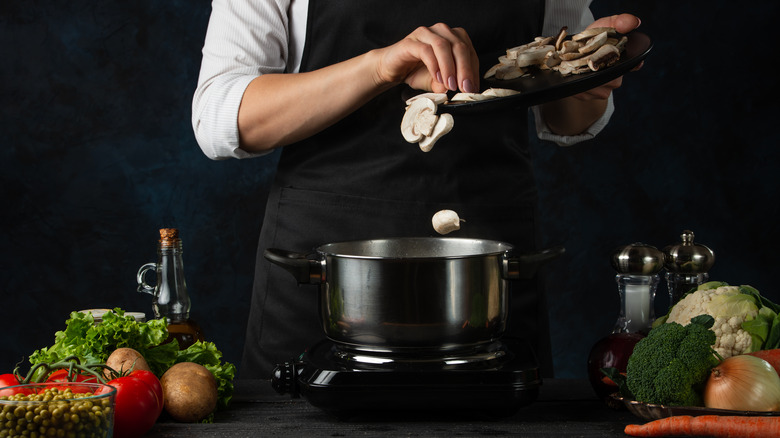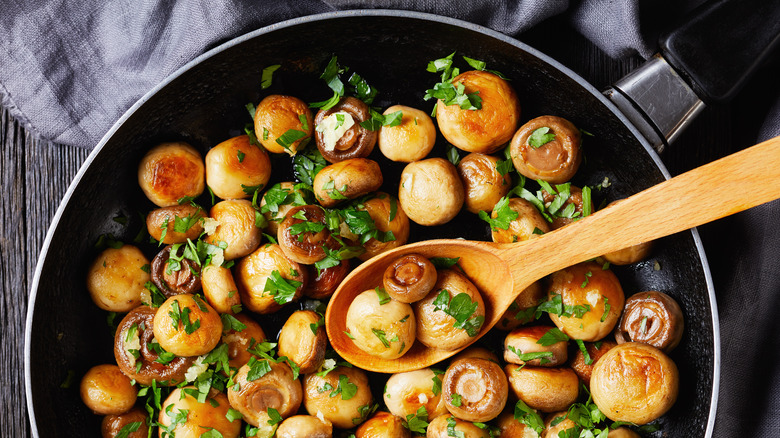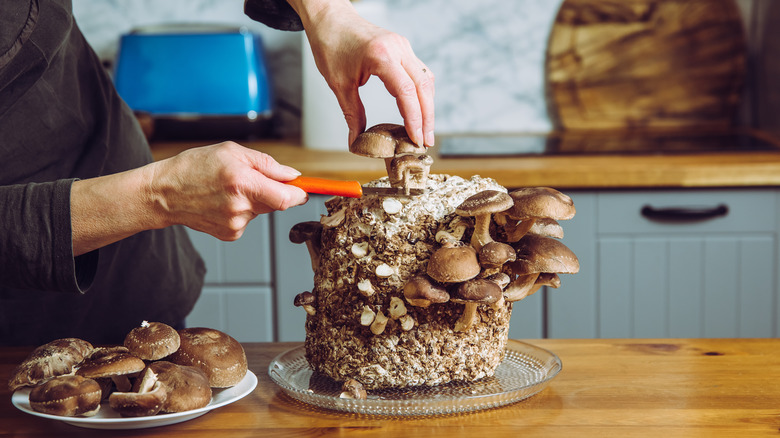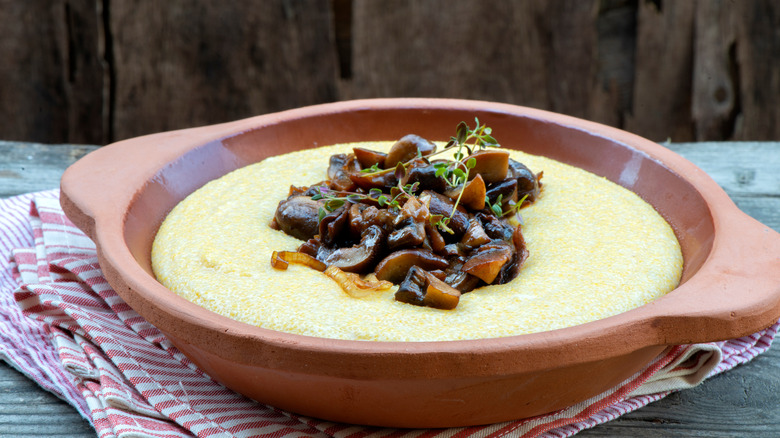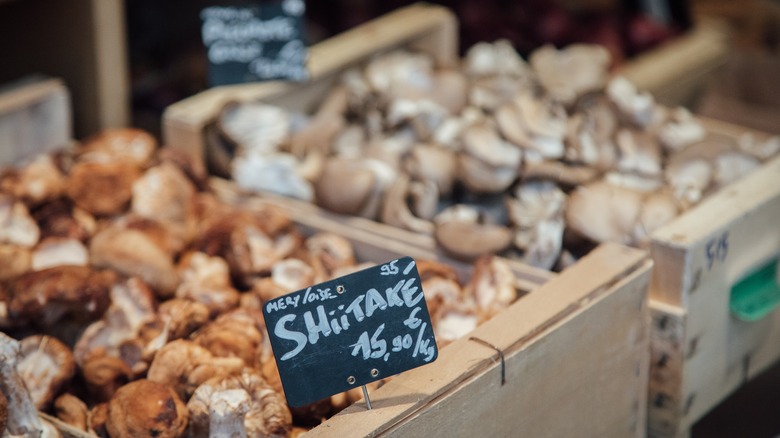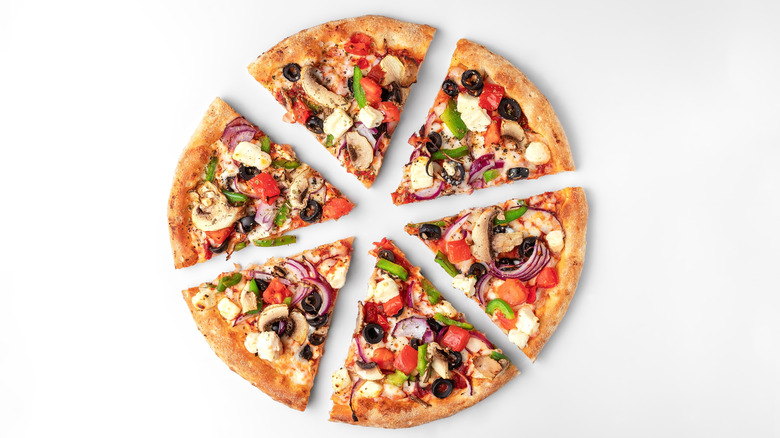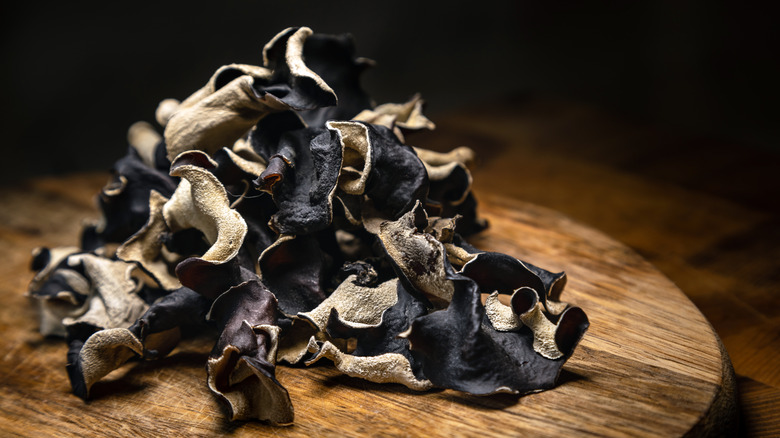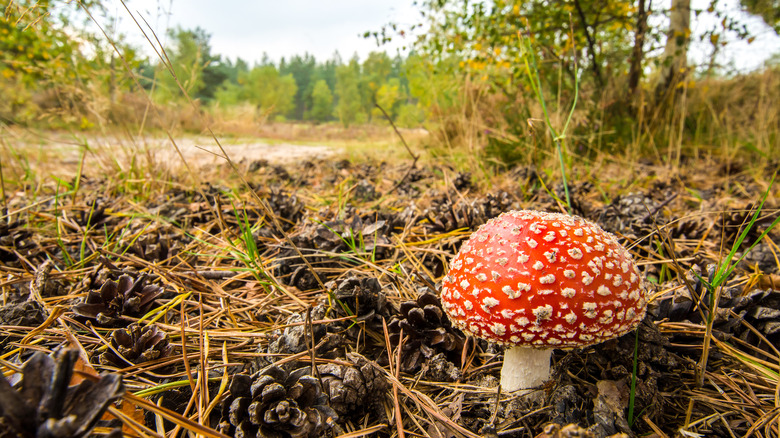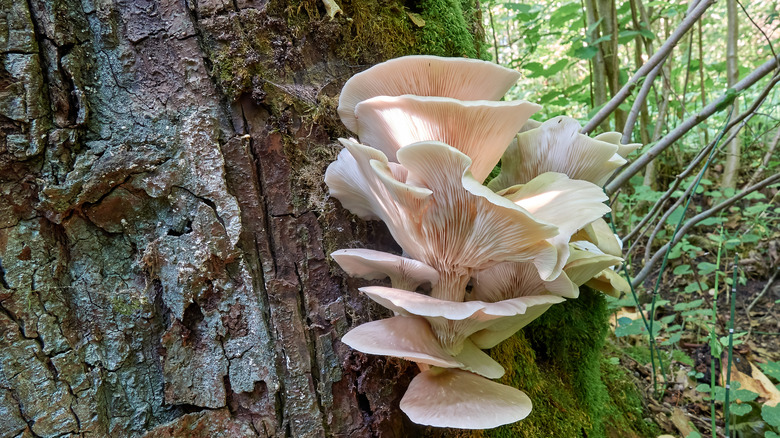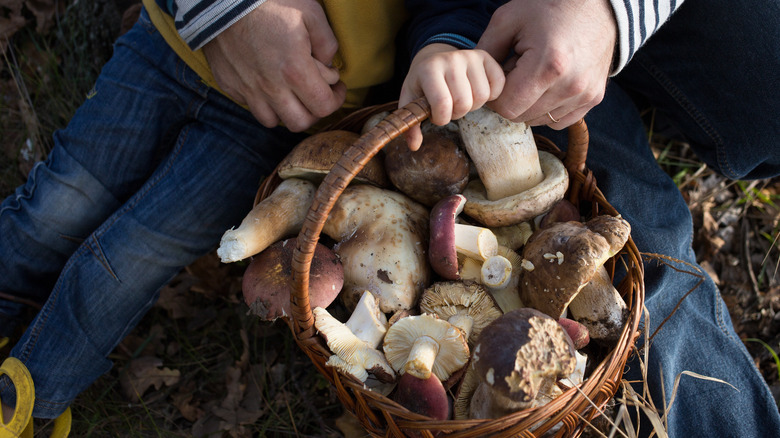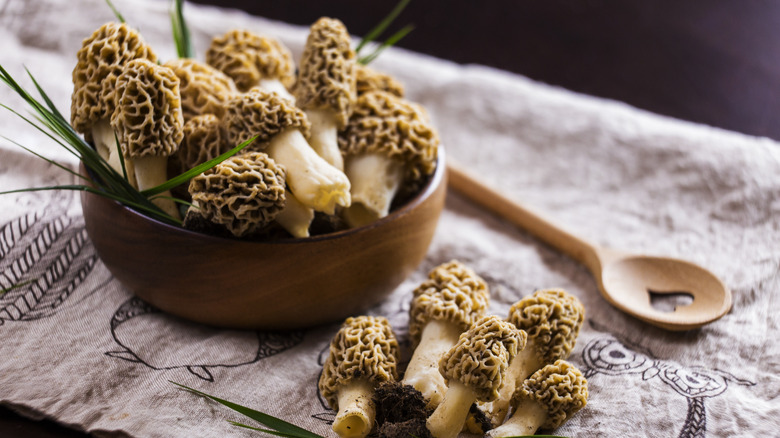13 False Facts About Mushrooms Everyone Actually Believes
Mushrooms are one of those foods that people tend to love or hate. Despite the prevalence of mushrooms in global cuisine, false ideas about cooking, eating, and foraging for them are still common. To be fair, it's easy to be confused even though mushrooms are a typical dinner option — neither fruit nor vegetable nor animal, mushrooms are a bit of a different beast from the rest of the produce section.
The practice of using mushrooms as food or for medicine is ancient, while French growers started cultivating fungi in caves in the 1600s (via SFGate). Today, the site says there are around 38,000 different types found all over the globe for humans can eat. Because of the multitude of varieties, people have a lot of opinions about mushrooms — especially differing opinions. Even the most common mushrooms can spark uncertainty over how to source, cook, and handle. Are mushrooms even that healthy? How can you avoid accidentally consuming toxic mushrooms when hunting for wild species in the outdoors? Why do they seem to become slimy as soon as you bring them home from the grocery store, anyway?
We decided to break down some of the biggest myths to clear up how to enjoy these culinary delicacies — such as putting away the butter, and why you can stop calling them a superfood, at least for now.
1. You need to pack mushrooms in air-tight containers for storage
Mushrooms can be tricky to keep fresh. Most everyone has reached into the fridge to find a package of slime-covered mushrooms shortly after bringing them home. Food52 explains fresh mushrooms should be stored in the fridge due to their high water content. Mushrooms contain 85-95% moisture, which releases as they age. This is why most store-bought packaging comes with holes to allow for moisture to escape. If you really want to protect the freshness of mushrooms, plastic packaging creates too tight of a seal for more than a couple of days.
Food52 recommends storing the fungi in a paper bag as the best method to help avoid the slime. The paper bag will absorb some of the moisture and help avoid the buildup of condensation that typically results in airtight containers. If you don't have a paper bag, then adding a paper towel can help absorb extra water that accumulates in a container. Mushrooms can stay fresh this way for up to a week.
2. You can't wash dirty mushrooms
According to the Centers for Disease Control and Prevention, it's important to wash fruits and veggies in running water, especially if you intend to consume them raw — proper washing helps ensure any pathogens lingering on the produce are killed. That said, fresh mushrooms — which are fungi — are not to be treated like other plants. Many home cooks wrongly believe that you can't rinse off mushrooms before cooking. Remember a quick rinse isn't the same as washing apples from the grocery store. Martha Stewart recommends placing your mushrooms in a water bath and then patting dry, but warns you'll need to use them right away: washed mushrooms don't last long in the fridge. The site explains the hallow and spongy morels are an exception: brush the textured mushrooms first before using any water.
Even though water isn't a major problem for mushrooms, it doesn't mean you need to rinse. Bon Appetit recommends skipping the faucet, and instead brushing mushrooms off with a wet towel. The cooking site especially recommends wiping wild, porous mushrooms such as "shiitakes, maitakes, lobsters, chanterelles, oysters, and morels," and goes as far as to recommend skipping the cleaning entirely if the mushrooms were bought from a reputable store or farmer's market. This is because mushrooms are prone to absorbing liquid, so mushrooms might be soggy if you're not cooking them afterward.
3. Frying is the best cooking method for mushrooms
One of the most common ways to cook fresh mushrooms is a sauté or sear in a little oil, fat, or butter. While combing fat and heat certainly is a delicious method, starting with water might be the best way to capture the perfect texture of well-cooked fungi. After all, mushrooms naturally release moisture when cooked. Though the technique may be controversial, one chef's secret to the perfect texture is boiling mushrooms in a small amount of water (just enough to cover them versus an amount you would use to boil pasta) before adding any flavorings, according to the Evening Standard.
Chef Jim Fuller explains to the Standard that mushrooms have a "unique cellular structure," so they won't over boil. Fuller adds more water as needed until they stop releasing water on their own, then once they're tender, allows the water to evaporate from the pan. Only at that time does he recommend adding a bit of oil to the pan if you want a crisp sauté.
4. Cook mushrooms on low heat for best results
One big myth is that mushrooms should be cooked at low heat to avoid burning. This couldn't be further from the truth. Mushrooms are full of water. For this reason, high heat is best to evaporate moisture. Fine Cooking explains that common white mushrooms will release their water during cooking, resulting in the fungi steaming and boiling in their own juices if the heat isn't high enough — and this makes it tough to get a nice brown on your mushrooms, plus you'll end up with soggy fungi. This is also why the site recommends avoiding overcrowding in the frying pan, and instead suggests putting in a small batch at a time so the liquid from each can burn off before more are added. The best method to sauté is by cooking mushrooms in small batches in a heavy pan where the oil is sizzling, according to Fine Cooking. If you're going to choose to sauté, might as well make the best mushrooms possible.
5. You should throw out the stems
Cooking mushrooms takes a bit of prep. Whether you're sautéing, grilling, or boiling mushrooms, you likely begin by chopping off and removing the stems. But don't make the mistake of discarding those stems into the garbage. Why not avoid adding to the 108 billion pounds of food waste every year in the United States, if you can? For mushroom varieties with delicate stems, the stems can typically be chopped up and included in the dish along with the caps, chef Will Horowitz told Self. Woodier stems from styles such as shiitake still make good mushroom stock, says Horowitz, even if they're not ideal for eating. You could also keep and dry the stems, and use the grindings to create a tea, as Horowitz does. Food52 also offers some other suggestions if your recipe calls for the removal of the stems from cremini and Portobello mushrooms – the site says they can be included in sauces, pasta dishes, or a vegetable paté.
6. Cook mushrooms in butter for a rich flavor
Mushrooms are delicious when cooked in a rich oil. Although mushrooms have plenty of nutritional value, they don't contain much fat. Many home cooks will reach for plain old butter to heat up mushrooms, and add some flavor to the bargain. That'd be the wrong move.
As Fine Cooking explains, a high temperature is what mushrooms need if you're going to sauté or sear mushrooms in a pan. For this purpose, clarified butter is a better choice than butter. You might be asking, what's the difference? As it turns out, butter will burn at 350 degrees Fahrenheit — a fairly low temperature when it comes to cooking — and burned butter will affect the taste of your dish and might even be unhealthy. Clarified butter, which is similar to ghee, eliminates the milk solids. It has a higher smoke point than regular butter, ideal for sautéing mushrooms.
You don't have to skip butter together. Another way to make mushrooms with butter, according to Lifehacker, is to wait to add the butter until the end. The site recommends cooking mushrooms without any oils at all, thanks to the water content of the fungi. You can add butter at the end after sautéing the mushrooms dry, which adds delicious flavor without the possible burnt taste.
7. Mushrooms aren't substantial enough to be healthy
Some people wrongly believe that mushrooms don't have any nutritional value. This is false. Mushrooms are full of vitamins and minerals, such as selenium, potassium, and vitamin D, says Time. The fungi are also a solid option for a low-calorie food with antioxidants and even protein. For this reason, mushrooms can be a great plant-based meat alternative. More than vegans and vegetarians are able to benefit from the protein. Cooking Light reminds us mushrooms do offer some fiber, just not a lot, so combine them with vegetables, beans, lentils, and sweet potatoes. And despite what we might want to believe, a pizza topped with mushrooms can't really be considered health food.
More about the potential benefits of mushrooms still needs to be explored. Popular Science reports compounds found in mushrooms are able to support the nervous system, less rates of cancer and heart disease, and could even help with tumors. All of these compounds offer potential health benefits in isolation, but science has yet to prove if consuming them in mushrooms will fight disease or make you live longer. Best to enjoy them as simply part of a balanced diet, for now.
8. Mushrooms are a vegan source of Vitamin D
Vitamin D is important to health because it helps the body absorb calcium, resulting in strong bones, muscles, and the immune system. Mushrooms are also sometimes touted as one of the few non-animal sources of vitamin D (via Healthline). But as it turns out, that's a hard maybe. Harvard School of Public Health explains that commercially sold fungi are often grown in controlled indoor environments, so they may not contain much vitamin D unless the grower exposes the plants to sunlight or uses UV lamps. The health site also explains that some varieties like white button, shiitake, and oyster mushrooms tend to contain less vitamin D because they flourish in lower-light conditions.
Dried mushrooms will offer a denser concentration of nutrients if stored in a cool dry location. So, you might get the most vitamin D out of your mushrooms if you pay attention to the growing conditions — or you're lucky enough to buy from a local grower who will tell you. The trick is knowing which mushrooms you're buying.
9. Fresh mushrooms are the best source of nutrients
Mushrooms are a nutritious food item thanks to their many naturally occurring minerals, antioxidants, and vitamins (via Time). Fortunately, dried mushrooms can offer even more health benefits than fresh ones. SFGate reports that dried mushrooms have a higher nutrient content and more flavor, which means they're shelf-stable and ideal for adding to your meal. Mushroom varieties also grow across the globe with shiitake, maitake, and reishi considered as the healthiest mushrooms rich in nutrients. You can also buy mushroom supplements if you don't like the taste.
Dried storage also allows mushrooms to last longer, up to one year whether bought at a store or dehydrated at home. Food blogger Miss Vickie finds dried mushrooms are convenient to add to soups and hearty stews thanks to the intense flavor. Keep in mind, even if you soak dehydrated mushrooms, they won't return to the full plumpness of a fresh mushroom. But they are still excellent in pastas, sauces, and gravy even if a little shriveled.
10. Most wild mushrooms are poisonous
Poisonous mushrooms are a huge risk because they're so common. Or are they? Turns out, it's a myth that most wild mushrooms are dangerous. While there are many more mushrooms than humans are able to eat, there isn't as much of a risk as many of us have believed. The Cleveland Clinic reports only 3% of mushrooms are poisonous — however, mushroom toxins can cause liver failure or death. So while there isn't an abundance of poisonous mushrooms in the wild, it's true that the stakes are high. The site explains the most common toxic mushroom is called a "death cap" for its white "umbrella-shaped tops and a cup at the base of their stem." They look similar to a variety you might find at the grocery store, so if you have any doubts when foraging in the wild, don't eat it.
Foragers in the U.S. might have even better odds than others worldwide. Food & Wine reports there are 10,000 different fungi found in North America, but only 100 are considered "dangerously poisonous" to humans, according to the North American Mycological Association. Despite only a small percentage of mushrooms being potentially fatal, the risks still mean you'll want to do your homework.
11. You can get sick by touching a poisonous mushroom
Foraging for food has become a major trend in the culinary world. Sourcing seasonal vegetables, herbs, and honey is commonplace for people living in rural and urban areas all over the country. Foraging for mushrooms is one of the major trends that isn't as simple as doing some research online. People who are uneducated when foraging for mushrooms could be hospitalized or worse if they wind up eating a poisonous variety (via the Cleveland Clinic). The reality is that due to the multitude of mushroom species, there are multiple visual characteristics that need to be identified and compared to a guide book to know if a specific mushroom is toxic or not (via Science Daily) — although there is a chemical test strip that is becoming available.
One pervasive myth is simply touching a toxic mushroom could land you in trouble. This is not true — the toxins must be ingested to sicken you. Treehugger recommends examining the mushrooms to better identify the characteristics, and even bringing two baskets for dividing any uncertain mushrooms for a closer inspection before cooking. Leave your dog at home, though. Accidents are more common with pets that eat the wrong mushroom and get sick as a result.
12. Foraging for mushrooms is only for experts
Common edible mushrooms in the wild can be mistaken for deadlier varieties (via Treehugger). Knowing what you're looking for and the risk involved is essential. But the idea that only forging experts can only search in the wild just isn't true. Out of the thousands of different mushrooms found in North America, only 100 or so are considered "dangerously poisonous," according to the North American Mycological Association. That said, eating the wrong mushrooms can send you to the hospital ... or potentially even the morgue. Some education is required for wild mushroom foraging. Looking for resources specific to your community is the best way to discover which mushrooms can be found locally and are safe to eat.
Wirecutter reports on various areas across the country, including the Pacific Northwest, Midwest, the Rockies, and even parts of the South, that each offer opportunities to forage for fungus. Buying a clear book to bring into the wild can be a reminder of the distinct characteristics you're looking for. Depending on the mushroom, popular wild species can be identified by gills versus ridges or smell, the site says. Worried? Leave anything you're not 100% sure about behind. Better safe than ill, and never eat wild mushrooms raw.
13. Morel mushrooms should be clipped at the stem when foraging to avoid damage
Morel mushrooms are one of the sought-after varieties out in the wild. Due to their popularity — and the sport of hunting them in the spring — myths around foraging have also propagated. Successful Farming explains that some mushroom hunters believe morel mushrooms will grow overnight into full-size caps. In reality, morels take a couple weeks to mature, although sizes vary greatly, helping to encourage the myth. Another foraging misconception is that morels need to be harvested in the soil to avoid damaging the larger underground system. Edible mushrooms are considered the fruit of the plant, the site says, so mushroom caps are similar to an apple in that the underground organism isn't harmed by removing one visible area. We encourage everyone to forage responsibly, but mushrooms are heartier than you might think.
The stem of the morel is a simple way to identify the fungi from its false copycats. Cutting the mushroom in half will reveal a true morel to be hollow. False morels, which is what the toxic variety is called, will be solid from stem to cap.
